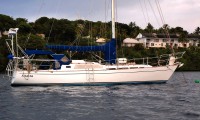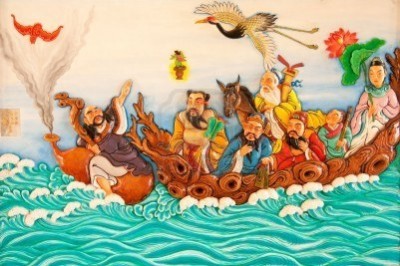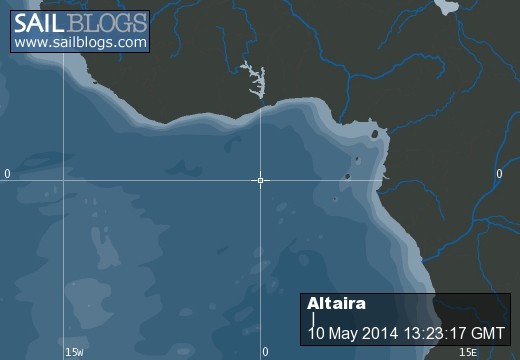Profile

Who: Kimball Corson. Text and Photos not disclaimed or that are obviously not mine are copyright (c) Kimball Corson 2004-2016
Port: Lake Pleasant, AZ
Altaira Wandering the Oceans
Favorites
- 7 Seas Cruising Association
- American Sailing Association
- Buoyweather Service
- CDC Traveler's Heath Advisories
- Cruiser Log venue
- Cruisers Forum
- Cruising Club of America
- Cruising Resources
- Cruising World Magazine
- Earthrace World Record
- Economic and Financial Indicators
- Economist Magazine
- Equipmment and Boat Reviews
- Float Plan Form
- Greenpeace Int'l
- Grib File Access
- Heavy Weather Sailing
- IMS Certificates
- Inland Travel: Expedia
- Intrade Prediction Markets
- Latitude 38
- London Financial Times
- Marine Books and Charts
- Marine Radios
- Nature Conservancy for Oceans
- New York Times
- NOAA Hurricane Analysis
- NOAA Weather Forecasts
- Noonsite, World Cruisng Info
- Ocean Cruising Club
- Overseas Mail Forwarding Services
- Practical Sailor Magazine
- RGE Economic Monitor
- Sail Gear Source I
- Sail Gear Source II
- Sail Gear Source III
- Sail Gear Source IV
- Sailboat Selection for Offshore Use
- Sailboats for Sale
- Sailing Items Sources Links
- SailMail (Marine Radio)
- Sailnet Sailing Information
- Seeking Alpha
- Tide & Current Program
- Tide Prediction Programs
- Tides & Currents
- TruthDig in the News
- U.S. Sailing Association
- Univ of Chicago Law Faculty Blog
- US State Dept Travel Advisories
- Voyage Planning (with pilot charts)
- Wall Street Journal
- Washington Post
- Weather.com
- Weather: MagicSeaweed
- Weather: Wetsand
- WinLink (Ham Radio)
- World Clock + Time Zones
09 April 2018 | Pago Pago, American Samoa
10 March 2018 | Pago Pago, American Samoa
10 March 2018 | Pago Pago, American Samoa
10 March 2018 | Pago Pago, American Samoa
22 August 2017 | Pago Pago, American Samoa
22 August 2017 | Pago Pago, American Samoa
22 August 2017 | Pago Pago, American Samoa
22 August 2017 | Pago Pago, American Samoa
22 August 2017 | Pago Pago, American Samoa
22 August 2017 | Pago Pago, American Samoa
22 August 2017 | Pago Pago, American Samoa
22 August 2017 | Pago Pago, American Samoa
22 August 2017 | Pago Pago, American Samoa
22 August 2017 | Pago Pago, American Samoa
22 August 2017 | Pago Pago, American Samoa
22 August 2017 | Pago Pago, American Samoa
22 August 2017 | Pago Pago, American Samoa
22 August 2017 | Pago Pago, American Samoa
22 August 2017 | Pago Pago, American Samoa
09 August 2017 | Pago Pago, American Samoa
The Role of Profits in a Competitive Economy
13 January 2013 | Pago Pago, American Samoa
Kimball Corson

The Role of Profits in a Competitive Economy
Most people mistakenly believe profits are the return on capital. Not so. Capital has its own separate return based on the value of its own marginal product. Profits are what is left over after all resources used in the productive process are paid what their marginal value to the process is. Profits are a something extra which has a key role in the economy that is properly grounded in change.
The purpose of profits in a truly competitive economy is to be an extra bit of money received that serves as an inducement for others to enter that industry. Profits attract more capital into that industry. Resources are thereby attracted away from industries that are just breaking even or actually losing money and induced into those with high profits. High profits tell entrepreneurs, capital and resource where they should go. They are a part of the system to create an optimal allocation of resources. In a stable unchanging and competitive economy where resources are optimally allocated, the level of profits in all industries will be zero. Labor and capital will both received a return equal to the value of their marginal values and there is no need for profits to exist to reallocate resources among and between industries.
Most conveniently, accountants don't really or often separate the return on capital from profits. They tend mistakenly to lump them together partly because the owner(s) of the business receive both so who cares. But they are not the same and their purposes are different. Most people therefore don't understand what profits are and what their purpose is.
When American businessmen moved their factories to China to take advantage of cheaper labor there, they received their usual returns on capital there but they acquired a large profit from what they saved on labor. That profit induced more businessmen to move production to China. Earlier, it was to Japan. But now Japanese wages and those in some other RIM countries have risen to levels where American wages are now again competitive.
What we observe is simply the competitive process working to equalize labor costs in the international world economy. Now, to save on labor costs which have risen in coastal Chinese cities, production is being moved into the more rural interior. The pursuit of profits results the better allocation of productive resources as profits work to equalize wages and thereby reduce the profits which induced the reallocations.
Profits can also be ill-gotten gains from taking advantage of natural monopoly elements in a market (large school districts and the market for teachers) or monopoly positions created artificially by establishing barriers to entry into markets. The AMA's restrictions on the number of doctors produced, thereby pushing their incomes above competitive levels and including an element of monopoly profit in those incomes. Competitive incomes would be those where all who could and wanted to went to medical school, all things considered.
That is what profits are and how they work in a competitive economy. That is also how they don't properly work in an economy with inadequate competition, usually because of legal restrictions which serve special interests at the expense of others or other what are called "barriers to entry."
Most people mistakenly believe profits are the return on capital. Not so. Capital has its own separate return based on the value of its own marginal product. Profits are what is left over after all resources used in the productive process are paid what their marginal value to the process is. Profits are a something extra which has a key role in the economy that is properly grounded in change.
The purpose of profits in a truly competitive economy is to be an extra bit of money received that serves as an inducement for others to enter that industry. Profits attract more capital into that industry. Resources are thereby attracted away from industries that are just breaking even or actually losing money and induced into those with high profits. High profits tell entrepreneurs, capital and resource where they should go. They are a part of the system to create an optimal allocation of resources. In a stable unchanging and competitive economy where resources are optimally allocated, the level of profits in all industries will be zero. Labor and capital will both received a return equal to the value of their marginal values and there is no need for profits to exist to reallocate resources among and between industries.
Most conveniently, accountants don't really or often separate the return on capital from profits. They tend mistakenly to lump them together partly because the owner(s) of the business receive both so who cares. But they are not the same and their purposes are different. Most people therefore don't understand what profits are and what their purpose is.
When American businessmen moved their factories to China to take advantage of cheaper labor there, they received their usual returns on capital there but they acquired a large profit from what they saved on labor. That profit induced more businessmen to move production to China. Earlier, it was to Japan. But now Japanese wages and those in some other RIM countries have risen to levels where American wages are now again competitive.
What we observe is simply the competitive process working to equalize labor costs in the international world economy. Now, to save on labor costs which have risen in coastal Chinese cities, production is being moved into the more rural interior. The pursuit of profits results the better allocation of productive resources as profits work to equalize wages and thereby reduce the profits which induced the reallocations.
Profits can also be ill-gotten gains from taking advantage of natural monopoly elements in a market (large school districts and the market for teachers) or monopoly positions created artificially by establishing barriers to entry into markets. The AMA's restrictions on the number of doctors produced, thereby pushing their incomes above competitive levels and including an element of monopoly profit in those incomes. Competitive incomes would be those where all who could and wanted to went to medical school, all things considered.
That is what profits are and how they work in a competitive economy. That is also how they don't properly work in an economy with inadequate competition, usually because of legal restrictions which serve special interests at the expense of others or other what are called "barriers to entry."
Comments
| Vessel Name: | Altaira |
| Vessel Make/Model: | A Fair Weather Mariner 39 is a fast (PHRF 132), heavily ballasted (43%), high-aspect (6:1), stiff, comfortable, offshore performance cruiser by Bob Perry that goes to wind well (30 deg w/ good headway) and is also good up and down the Beaufort scale. |
| Hailing Port: | Lake Pleasant, AZ |
| Crew: | Kimball Corson. Text and Photos not disclaimed or that are obviously not mine are copyright (c) Kimball Corson 2004-2016 |
| About: | |
| Extra: |
Altaira's Photos - Main
No items in this gallery.
Profile

Who: Kimball Corson. Text and Photos not disclaimed or that are obviously not mine are copyright (c) Kimball Corson 2004-2016
Port: Lake Pleasant, AZ
Altaira Wandering the Oceans
Favorites
- 7 Seas Cruising Association
- American Sailing Association
- Buoyweather Service
- CDC Traveler's Heath Advisories
- Cruiser Log venue
- Cruisers Forum
- Cruising Club of America
- Cruising Resources
- Cruising World Magazine
- Earthrace World Record
- Economic and Financial Indicators
- Economist Magazine
- Equipmment and Boat Reviews
- Float Plan Form
- Greenpeace Int'l
- Grib File Access
- Heavy Weather Sailing
- IMS Certificates
- Inland Travel: Expedia
- Intrade Prediction Markets
- Latitude 38
- London Financial Times
- Marine Books and Charts
- Marine Radios
- Nature Conservancy for Oceans
- New York Times
- NOAA Hurricane Analysis
- NOAA Weather Forecasts
- Noonsite, World Cruisng Info
- Ocean Cruising Club
- Overseas Mail Forwarding Services
- Practical Sailor Magazine
- RGE Economic Monitor
- Sail Gear Source I
- Sail Gear Source II
- Sail Gear Source III
- Sail Gear Source IV
- Sailboat Selection for Offshore Use
- Sailboats for Sale
- Sailing Items Sources Links
- SailMail (Marine Radio)
- Sailnet Sailing Information
- Seeking Alpha
- Tide & Current Program
- Tide Prediction Programs
- Tides & Currents
- TruthDig in the News
- U.S. Sailing Association
- Univ of Chicago Law Faculty Blog
- US State Dept Travel Advisories
- Voyage Planning (with pilot charts)
- Wall Street Journal
- Washington Post
- Weather.com
- Weather: MagicSeaweed
- Weather: Wetsand
- WinLink (Ham Radio)
- World Clock + Time Zones
